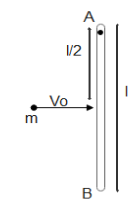
A uniform rod $AB$ which is free to swing in the vertical plane about a horizontal axis through $A$, hanging freely. A particle of equal mass strikes the rod with a velocity ${v_o}$ and gets stuck to it. Find the angular velocity of the combination immediately after the collision.


Answer
492.3k+ views
Hint: We are given a rod that is free to swing in the vertical plane about a horizontal axis. It is then collided upon by a mass of a certain velocity and it gets stuck to the rod and we need to find the angular velocity after the collision.
Complete step by step answer:
Since no external torque is applied to the body, therefore, the angular momentum will be conserved about point A after and before the collision of the system.Hence we can write
${L_1} = {L_2}$
Where ${L_1}$ is the angular momentum of the system when the mass was away from the rod and was approaching it and ${L_2}$ is the angular momentum of the system when the mass gets stuck to the rod.
Therefore substituting the values we get
${I_1} \times 0 + m{v_o}\dfrac{l}{2} = {I_2} \times \omega - - - - (1)$
Since $L = mvr = I\omega $ and the distance of the mass particle from the point is given in the figure as half the length of the rod. The initial angular momentum of the rod will be zero
Now we that the moment of inertia about the end of the rod is equal to
${I_1} = \dfrac{1}{3}m{l^2}$
Where $m$ is the mass of the rod as well as the particle
And the moment of inertia of the particle about point A will be equal to $\dfrac{{m{l^2}}}{4}$
Therefore the moment of the inertia of the system after the mass is tuck to it will be
${I_2} = \dfrac{{m{l^2}}}{4} + \dfrac{{m{l^2}}}{3}$
$ \Rightarrow {I_2} = \dfrac{{7m{l^2}}}{{12}}$
Therefore the substituting the value in equation 1) we get
$m{v_o}\dfrac{l}{2} = \dfrac{{7m{l^2}}}{{12}} \times \omega $
$\therefore \omega = \dfrac{{6{v_o}}}{{7l}}$
Which is the required expression for the angular velocity of the particle mass just after the collision.
Note: When no external torque is applied to a rotating system then its angular momentum is conserved which means no change will occur in its angular momentum. The moment of inertia of a body is its tendency to resist angular acceleration, which is the sum of the products of the mass of each particle in the body with the square of its distance from the axis of rotation.
Complete step by step answer:
Since no external torque is applied to the body, therefore, the angular momentum will be conserved about point A after and before the collision of the system.Hence we can write
${L_1} = {L_2}$
Where ${L_1}$ is the angular momentum of the system when the mass was away from the rod and was approaching it and ${L_2}$ is the angular momentum of the system when the mass gets stuck to the rod.
Therefore substituting the values we get
${I_1} \times 0 + m{v_o}\dfrac{l}{2} = {I_2} \times \omega - - - - (1)$
Since $L = mvr = I\omega $ and the distance of the mass particle from the point is given in the figure as half the length of the rod. The initial angular momentum of the rod will be zero
Now we that the moment of inertia about the end of the rod is equal to
${I_1} = \dfrac{1}{3}m{l^2}$
Where $m$ is the mass of the rod as well as the particle
And the moment of inertia of the particle about point A will be equal to $\dfrac{{m{l^2}}}{4}$
Therefore the moment of the inertia of the system after the mass is tuck to it will be
${I_2} = \dfrac{{m{l^2}}}{4} + \dfrac{{m{l^2}}}{3}$
$ \Rightarrow {I_2} = \dfrac{{7m{l^2}}}{{12}}$
Therefore the substituting the value in equation 1) we get
$m{v_o}\dfrac{l}{2} = \dfrac{{7m{l^2}}}{{12}} \times \omega $
$\therefore \omega = \dfrac{{6{v_o}}}{{7l}}$
Which is the required expression for the angular velocity of the particle mass just after the collision.
Note: When no external torque is applied to a rotating system then its angular momentum is conserved which means no change will occur in its angular momentum. The moment of inertia of a body is its tendency to resist angular acceleration, which is the sum of the products of the mass of each particle in the body with the square of its distance from the axis of rotation.
Recently Updated Pages
In a parallel plate capacitor the distance between class 11 physics CBSE

Along a streamline A The velocity of a fluid particle class 11 physics CBSE

A rope is wound around a hollow mass of 3 kg and radius class 11 physics CBSE

The synthesis of alkyl fluorides is best accomplished class 11 chemistry CBSE

How many and what types of bonds are present in NH4 class 11 chemistry CBSE

A force of 40N acts on a point B at the end of an Lshaped class 11 physics CBSE

Trending doubts
10 examples of friction in our daily life

One Metric ton is equal to kg A 10000 B 1000 C 100 class 11 physics CBSE

Difference Between Prokaryotic Cells and Eukaryotic Cells

1 Quintal is equal to a 110 kg b 10 kg c 100kg d 1000 class 11 physics CBSE

State the laws of reflection of light

Explain zero factorial class 11 maths CBSE




